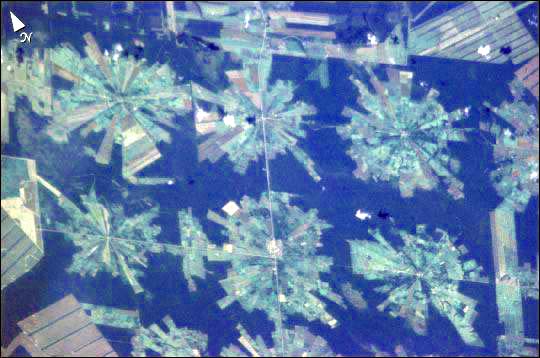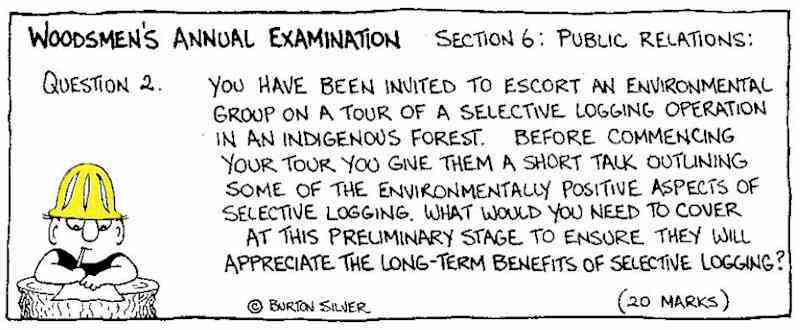Naturally Important
Partnership is the Key to Saving Unique HabitatsThe system of nature, of which man is a part, tends to be self-balancing, self-adjusting, self-cleansing. - E F Schumacher
by Eric Cairns Ownership of land is generally part of a business, and most businesses expect a return on capital. So if you own a farm which includes native bush or scrub or a herb field, you probably still have to pay rates (and mortgage) on it. Wouldn't it be nice if it earned some income? Wouldn't it be even better if it wasn't destroyed in the process of earning its keep? District and local councils are systematically identifying significant native ecosystems (habitats) in their areas. But farmers fear that precious habitat or significant features on their own land will be locked up without consultation or compensation. Some farmers have even destroyed that habitat in order to avoid possible future restrictions over the use of their land. Perhaps, being a greenie, you have decided to protect and enhance the wilderness parts of your land, or even placed a permanent protection covenant on those parts. If you are lucky, the QEll trust helped you with fencing costs and perhaps the local council offered rates relief. However, the true beneficiaries, the general public and our descendants, bear little of the costs. And the direct costs carry on. Capital, rates and interest costs, pest and weed control, maintaining fencing, fire protection et cetera. It would be rare for such precious habitat to thrive without assistance. Valuable habitat is not just pristine, untouched wilderness (there's not much of that anyway). A significant part of our plants and animals could also be supported on reverting farmland, large gardens and mixed species wood lots/shelter belts. Some of these could even be periodically harvested in a low impact way, without seriously detracting from their habitat value. The current publicity on a National Biodiversity Strategy highlights the need to protect and enhance our unique and precious flora and fauna by protecting their habitats. But our National conservation estate (that managed by DoC) does not evenly represent NZ's native or introduced biodiversity. Hence the importance of privately owned habitat. But many such privately owned blocks are dysfunctional in that they are often small, disconnected and unstable and the costs of protection or maintenance falls on the few. Through financial pressures, ignorance or neglect, much of the privately owned habitat will be further degraded unless there is substantial community support and co-ordination of resources. Such habitat degradation can be reversed. New habitat can substantially be recreated over time, but only if individual species or local provenances are not yet extinct. But if the local council or DoC start to tell you what you can or can't do on your land, don't the hackles rise? How dare they take away your rights! Councilors and planners take note. Rather than confiscate or restrict use of ecologically sensitive private land, how much better would it be to create a system where landowners willingly sought to protect and enhance their precious habitats so that the whole community would benefit. Wellington-based policy analyst (and part-time forester) Chris Livesey has used the Banks Peninsula situation to propose a scheme whereby environmental assets can be managed, traded and generate income for the land owner. Such an approach should be much more acceptable to landowners, because they are then willing partners and could negotiate levels of service or limit the length of contract. The three objectives are to:
Chris argues that by placing real market values on these assets, they will be better managed because the carers will be rewarded for their responsibility. There would also be improved delivery of the community conservation objectives. Chris calls this concept Habitat Farming (HP). Similar schemes exist in several OECD countries and some elements of the HP proposal already exist with several NZ councils. Chris' proposal is detailed but some of the elements are as follows:
The length of time for which protection was offered would also be subject to contract, for example 20 years or in perpetuity. A temporary contract is reasonable, as many habitats are rapidly changing and could equally emerge elsewhere (such as regenerating shrub forest or tussock/herb field). Legal instruments which can bind an owner to deliver on such conservation contracts already exist in the form of either encumbrances or covenants. These can be registered on land titles and can bind successive owners and occupiers. Although Chris' concept was written around the protection of native ecosystems, perhaps it could reasonably be extended to other areas of public interest, such as conservation of landscapes or perhaps exotic biodiversity. As a tree cropper, I'm keen on gene-banking heritage fruit and nut trees, and continuous cover forestry. Try putting a community value on working farms with hedgerow corridors (wood lots) linking isolated patches of native bush, or mixed species wood lots which were harvestable but never clear felled. Surely gene-bank collections of food-bearing plant varieties is of national importance, as much of NZ's exotic biodiversity is scattered in private hands. Eric Cairns is a member of the NZ Tree Crops Association Source: Straight Furrow
How Spruce Lane Got Its Name...
Clearcutting's Soil EffectsThe Axe forgets, but not the tree. - African proverb
In their work, Ingham and her colleagues compared the soil populations of a variety of organisms in a large forest area, measuring hundreds of meters on a side, before and after it was clearcut. By 6 to 9 months after the trees were cut, the underground fungal biomass had declined to about 1/10 of what it was before logging started, Ingham says. Also lost were roundworms and some arthropods, such as springtails and mites. Microbial populations were affected as well. One indication of that came about one year after the clearcut when Ingham and Dennis Knight of the University of Wyoming in Laramie measured a large surge of nitrogen concentrations in groundwater, probably reflecting the death and decay of nitrogen-storing microbes. And the losses of soil organisms only get worse with time: Ingham found that soils were showing a 100-fold decrease in fungal biomass and significant loss of nitrogen 5 years after clearcutting. Ingham says that these changes reflect the fact that trees provide a source of carbon to subterranean microbes so that when forests are clearcut, some microbes are starved of nutrients. She notes, for example, that smaller gaps in the forest canopy, measuring just tens of meters on a side, did not seem to have such a disastrous effect on soil organisms, presumably because microorganisms moving in from surrounding areas help to keep a healthy underground environment. Conversely, soil microbes help nourish trees by providing them with water and minerals. Indeed, without a healthy microbial population, reforestation efforts may fare poorly. As many as 75% of Douglas fir seedlings died when they were planted in the clearcut areas studied by Ingham. Reforestation efforts might fare better, Ingham suggests, if they begin within 6 to 9 months of logging. Leaving more mature trees and keeping large, soil-compacting machinery out of logged areas might also aid reforestation by helping maintain underground biological systems. Source: Science Vol 261 27 August 1993 photo credit Kenneth W Fink, Photo Researchers
Sown, not Sewn? A Forest Quilt
Normally, a rectangular forest stripping pattern is common. However, another pattern, which could be called stellate, involves deforestation outward from a common centre, as shown in the astronaut photo of an area in eastern Bolivia. Source: rst.gsfc.nasa.gov
Selective Logging, Anyone?
Source: Bogor by Burton Silver, Silviculture Press 1985 If selective logging's no good and clearcutting's no good, perhaps we could just leave our remaining indigenous forests alone for now?
For pages on several types of natural disasters - including lightning strikes, tornados, hurricanes, volcanoes, floods, global warming and more - as well as some great satellite
and tree photos, clicking the "Up" button immediately below takes you to the Table of Contents page for this Environment section. |
 Animals
Animals Animation
Animation Art of Playing Cards
Art of Playing Cards Drugs
Drugs Education
Education Environment
Environment Flying
Flying History
History Humour
Humour Immigration
Immigration Info/Tech
Info/Tech Intellectual/Entertaining
Intellectual/Entertaining Lifestyles
Lifestyles Men
Men Money/Politics/Law
Money/Politics/Law New Jersey
New Jersey Odds and Oddities
Odds and Oddities Older & Under
Older & Under Photography
Photography Prisons
Prisons Relationships
Relationships Science
Science Social/Cultural
Social/Cultural Terrorism
Terrorism Wellington
Wellington Working
Working Zero Return Investment
Zero Return Investment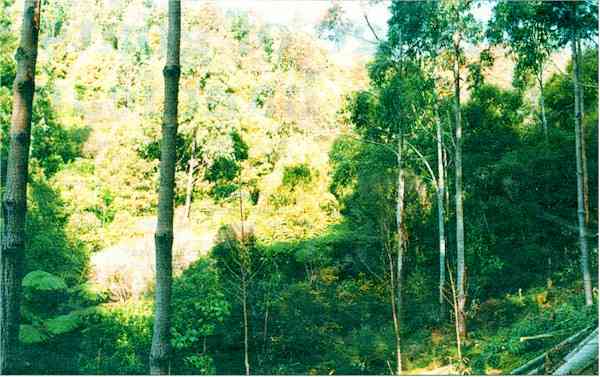
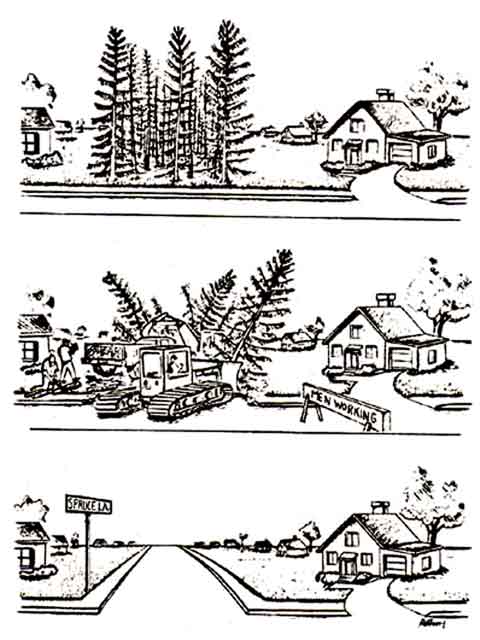
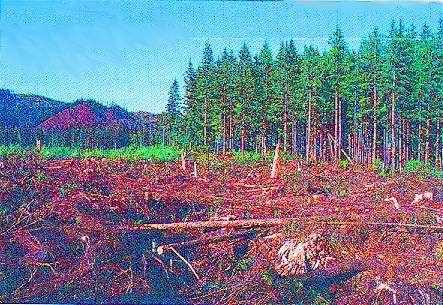 When a forest is clearcut, the environmental degradation that occurs above ground is
obvious. Less obvious, but equally cataclysmic, is the damage that goes on underground - the loss of fungi, worms, bacteria, and other microbes that can nourish plants or protect
them from disease. "Soils can be biologically destroyed, even if they seem physically intact, holding most minerals and topsoil," says Elaine Ingham, a soil microbiologist at
Oregon State University in Corvallis, reporting the results of her group's analyses of soils from a clearcut forest on the Olympic Peninsula. This loss of subterranean life-forms
is important because it can impair efforts to restore forests, although the research is also suggesting ways to improve reforestation.
When a forest is clearcut, the environmental degradation that occurs above ground is
obvious. Less obvious, but equally cataclysmic, is the damage that goes on underground - the loss of fungi, worms, bacteria, and other microbes that can nourish plants or protect
them from disease. "Soils can be biologically destroyed, even if they seem physically intact, holding most minerals and topsoil," says Elaine Ingham, a soil microbiologist at
Oregon State University in Corvallis, reporting the results of her group's analyses of soils from a clearcut forest on the Olympic Peninsula. This loss of subterranean life-forms
is important because it can impair efforts to restore forests, although the research is also suggesting ways to improve reforestation.